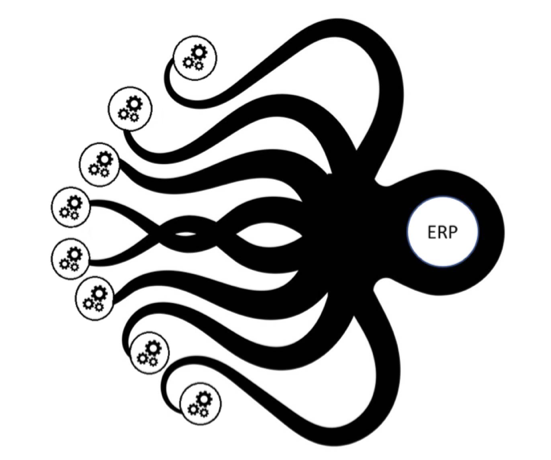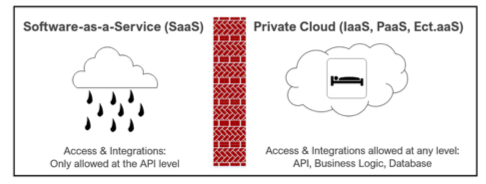Cloud ERP: Confused as a mollusk and dumber than a brick wall?
In discussing integrated application ecosystems, metaphors are often helpful in understanding the challenges associated with cloud migrations and the implications associated with the options selected when migrating an integrated ERP platform. Sometimes conceptualized as a “hybrid cloud,” any time an ERP system integrates with application extensions, homegrown solutions, or third-party applications, we move beyond a simple cloud platform into a hybrid ecosystem. Read on to learn more about hybrid cloud infrastructure.

Cloud migrations can be complex, especially when a migration includes more than simply an ERP system. A stand-alone ERP system can be assessed at face value: depending on the needs of the business, the functionality of the various versions of the software, and the resources available, a company can come to a relatively clear deployment decision. But when we begin to discuss the company’s hybrid cloud architecture — the ERP application and its integrated extensions — the waters get inky-dark and murky in a hurry.
Enter the confused octopus. One helpful metaphor in understanding cloud migrations is to liken an application’s ecosystem to a confused octopus.

An ERP hybrid cloud is a body with many tentacles. And the tentacles don’t always get along with the head — or with each other, for that matter. While each tentacle is joined in some manner with the head, the lifecycle of each tentacle is independent of the parent ERP system. While an ERP system may move from an on-premise architecture to a Software-as-a-Service model (SaaS), a given extension may be designed to only interact at the database server level and may no longer be receiving updates. Simply put, the tentacles advance at their own pace — some may advance more rapidly or more slowly than the main ERP system.
As such, if we were to view a private cloud migration as the movement of an octopus though the ocean, you’d discover that some tentacles keep up with the head, while others may actually surpass the head, while others still stand in place, slowly stretching and extending their ever-thinning connection as the head moves further and further away. And in some cases, a tentacle may stretch so far as to snap off entirely. For instance, if the head of the mollusk slithers into SaaS and one of the tentacles still languishes in the deep trenches of SQL stored procedures, we might be in deep… water!
So why is it that the movement of the ERP animal’s head might estrange one of its third-party tentacles?
Perhaps another metaphor would help clarify our conundrum. Let’s talk about brick walls. The truth is, there’s a hidden brick wall hovering in the cloud, as it relates to access and control. When it comes to the level of access and control required to integrate with third-party extensions, the differences between Software-as-a-Service and private cloud architectures are monumental.
On the SaaS side of the wall, interactions are only allowed at the API-level of the parent application. Conversely, a private cloud platform can allow interactions at any level, whether the API, the business logic level, or even at the database, if necessary.
As such, understanding the necessary level of access and control to support hybrid cloud integrations is fundamental to a successful cloud migration. If you move your base ERP system onto a platform that the third-party applications cannot successfully interact with, you might discover that you’ve left several applications behind, no longer able to leverage them as part of your hybrid cloud ecosystem. I have seen cases where customers moved their ERP systems to a Software-as-a-Service deployments, only to realize that they had to essentially re-write their third-party integrations, and even some of their third-party applications entirely, to be able to interact with their new SaaS platform. They ran head first into the cloud’s hidden brick wall and spent six months of development and integration time and expense for their troubles.
While the explanations are metaphorical, the implications are as real as it gets. Are you considering a migration to the cloud? Carefully consider the implications. Take a thorough audit of the third-party extensions that comprise your hybrid ecosystem, and understand how they are constructed.

Then understand how they might also migrate in order to be able to interact with the parent ERP system in each deployment scenario, be it in a SaaS environment or as part of a private cloud. These considerations can help save a lot of grief and trauma during implementation, so make them before you bind yourself to a given path.
Mixed metaphors, even in hybrid cloud infrastructure, are rarely a good thing, so I doubt I’ll run into many mushy mollusks swimming though the ether and squishing themselves up against hidden walls in my future cloud adventures. Until then, I will have my eyes set on both the sky and the sea.

